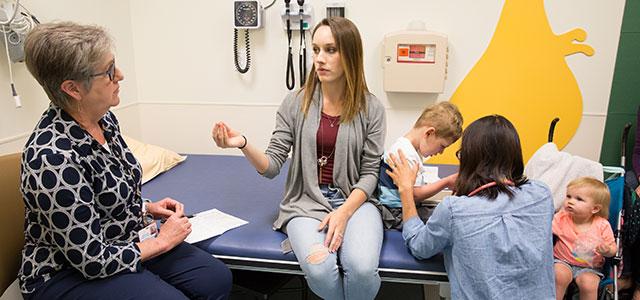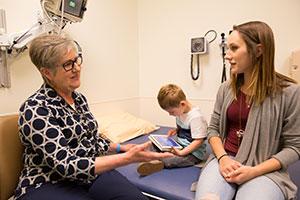
As Barbara Bratton (left) speaks with the patient’s mother in the UCSF LIFE Clinic, pediatric surgeon Lan Vu examines the child (photos by Elisabeth Fall).
Alumna Called Moral Compass for UCSF LIFE Clinic
When newborns need surgery because of rare birth anomalies, the conditions themselves and the aftereffects of surgery often threaten health and well-being long into adulthood.
Pediatric nurse practitioner Barbara Bratton (MS ’88) understands the threats all too well. The clinical coordinator for the UCSF LIFE (Long-term Infant-to-adult Follow-up and Evaluation) Clinic, Bratton helps children and their families cope with everything from neurodevelopmental delays and respiratory and nutritional problems through hearing loss and social isolation.
The LIFE Clinic was originally part of a research project that looked at long-term quality-of-life issues for survivors of fetal surgery for congenital diaphragmatic hernia (CDH) – a condition in which a hole in the diaphragm allows abdominal organs to move into the chest and prevent the lungs from developing normally. Over time, however, the clinic has evolved into one of the first in the country dedicated to long-term, interdisciplinary follow-up care for children born with a range of rare anomalies.
“We would see the same social and medical issues over and over again, so it made sense to think and talk about these issues early and follow people long-term,” says Bratton about the clinic’s evolution. “Also, because these children often have multiple comorbidities, we wanted to make multiple specialists available, including pulmonary and GI [gastrointestinal] physicians, social workers, dietitians and feeding therapists.”
Partnership Enables Clinic to Grow
Bratton has been at UCSF since she arrived in California in 1982 as an RN and took a job in the intensive care nursery at what is today UCSF Benioff Children’s Hospital San Francisco. After graduating from UCSF School of Nursing’s pediatric nurse practitioner program in 1988, she went first to the pediatric GI service before moving to pediatric surgery in 1996.
She assumed her role at the LIFE Clinic a decade later, when the fetal surgery study ended and the nurse following the patients moved on. It was then that Bratton met surgeon Lan Vu, a resident at the time, who was very interested in understanding the long-term outcomes of her patients.
 From left: Occupational therapist Miriam Crennan, dietition Carrie McFarland, pediatric surgeon Lan Vu and Barbara Bratton discuss their CDH patient. Their partnership, which continues to this day, dramatically accelerated the LIFE Clinic’s growth.
From left: Occupational therapist Miriam Crennan, dietition Carrie McFarland, pediatric surgeon Lan Vu and Barbara Bratton discuss their CDH patient. Their partnership, which continues to this day, dramatically accelerated the LIFE Clinic’s growth.
“I would say we have a clinic because of her,” says Bratton of Vu. “She helped us develop a set of questions we still use today in follow-up, and she does an incredible job working with the families.”
Vu contends simply, “Barbara really started the program; she is our moral compass.”
After her residency, Vu left for two years to complete a fellowship, but when she returned, the clinic began to expand beyond CDH to include other diagnoses, beginning with anorectal malformations, a spectrum of conditions that can make it a challenge for children to have regular bowel movements without accidents.
“For these children, the most important thing is to be clean and out of diapers,” says Bratton.
As other congenital anomalies became part of the clinic’s purview, the LIFE team began to develop follow-up protocols for each condition, which begin with multidisciplinary inpatient rounds that involve Bratton, a surgeon, a dietitian and a social worker collaborating with other clinicians to respond effectively to the rare anomalies.
“We bring our experience in both the inpatient and outpatient settings to help educate other providers,” says Bratton.
Then, prior to discharge, the LIFE team will interview families and develop a set of care recommendations. “These are usually a combination of standard protocols and what makes sense for each individual child,” says Bratton.
During the first postoperative year, the clinic typically sees patients quarterly to monitor both the aftermath of surgery and potential developmental problems. Over time, visits taper to twice a year, then once a year into adulthood as long as there are no significant challenges.
For those who live far away and can’t make the visits, Bratton works with the families to identify providers in their area. “We do what we can by phone or email, so families don’t have to travel unnecessarily,” she says.
Creating an Essential Niche
 In all of these interactions, Bratton applies her NP training in a variety of ways. “It’s interesting how nurses can make jobs for themselves that didn’t exist before,” she says.
In all of these interactions, Bratton applies her NP training in a variety of ways. “It’s interesting how nurses can make jobs for themselves that didn’t exist before,” she says.
Though she will sometimes do independent assessments, a lot of the work is in collaboration with the surgeons because of the complexity of the patients’ conditions.
“I also help families look at the big picture and work closely with community pediatricians to make sure there is continuity from the patients’ time in the hospital through their transition to home and beyond,” she says. “As an experienced NP, I can be a clinical expert and resource to clinicians who don’t see these types of patients every day.”
Ongoing education is another important role. The LIFE team has developed tools and resources, including a series of free iBooks for both patients and primary care providers, as well as a course and a support group for parents.
“What we do is not typical of most surgical practices in the US,” says Bratton. “I’ve learned so much from our families over the years, and that allows me to turn around and share it with others.”



